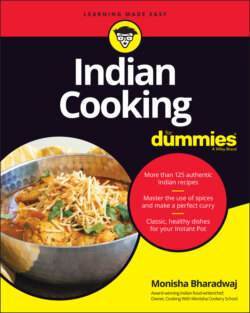Читать книгу Indian Cooking For Dummies - Monisha Bharadwaj - Страница 62
Grains
ОглавлениеYour Indian meal will always have grains as a part of it. The grains could be in the form of rice or breads made with wheat or lentil flours. Although the variety of Indian ingredients in supermarkets keeps growing, you’ll probably find a larger variety at an Indian grocery store. It’s worth a trip just for the wonderful aromas and unusual ingredients you’ll see — you won’t need to buy them all! Table 4-2 lists the ones you’ll want to stock up on.
TABLE 4-2 Buying Grains
| Grain | Description |
|---|---|
| Atta | A stoneground (called chakki on Indian packaging) whole-wheat flour used for making rotis, parathas, and other breads. You can’t use whole-meal flour instead, so if the recipe calls for atta, use atta. |
| Besan | A kind of chickpea flour used for batters for fritters like pakora, to make gluten-free breads, or for thickening curries |
| Poha | A dried flaked rice that rehydrates easily to make a quick, hearty snack when cooked with spices. It’s available as “fine” or “medium”; I always buy the medium because it holds its shape better. |
| Rice | Indian basmati rice is available in most stores. Look for aged, mature, or old basmati (you’ll often see these terms on the packaging) because it’ll fluff up better. Or if you can’t bother to read labels, just buy the most expensive one because it’s likely to be the best aged. Cheaper basmati is good for rice pudding and for blending into a batter for rice and lentil pancakes called dosa. |
| Semolina | Wheat broken down into various-sized grains. Coarse semolina is used in puddings and pancakes, and fine semolina is used as a crust for fried shrimp and fish. |
